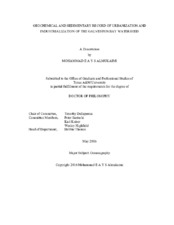| dc.description.abstract | Over the last 100 years, the Galveston Bay (GB) Estuary has experienced a wide range of anthropogenic activities. The bay’s watershed and shoreline contains one of the largest concentrations of petroleum and chemical industries in the world, with the greatest concentration within the lower San Jacinto River/Houston Ship Channel (SJR/HSC). Extensive groundwater has been withdrawn to support these industries, and an expanding population has resulted in elevated land subsidence, with the highest rates in the lower SJR/HSC (3 cm yr^-1, > 3 m) decreasing seaward throughout the bay to 0.6 cm yr^-1 near Galveston Island. Due to the industrial, commercial, and residential importance of the GB watershed, understanding the sources of sediment, and the rates of accumulation is imperative in determining the concentration, inventory and fluxes of trace metals (e.g., Hg) in the environment. Moreover, these data may be used to minimize the impact on public health, and reconstruct the historical input for improving management strategies. To examine the anthropogenic alteration in the system, 22 sediment vibra-cores were collected throughout the bay and analyzed using ^210Pb and ^137Cs radioisotope geochronology, grain size, XRF, X-radiography, Hg concentration, lignin content and composition, and stable carbon and nitrogen isotopes. Geochronology from these cores was used to determine sedimentation rates and correlated to Hg profiles to estimate input histories. The results show the highest sedimentation rates correspond to areas of highest Relative Sea Level Rise (RSLR), and are of the same order of magnitude. In general, sedimentation rates are as much as 50% of RSLR, indicating that sedimentation has not kept pace with land subsidence. Profiles show significant input of Hg beginning in the 1900s, with highest concentrations between the 1960s-1970s, with a substantial decrease in concentration since, demonstrating it to be a valuable geochronology tool. Hg concentrations were found to be significantly higher proximal to the SJR/HSC, progressively decreasing seaward and to distal parts of the bay. Results of δ^13C and lignin analyses indicate there is a significant terrestrial input of organic matter, and the system has shifted from being a marine to terrestrial dominated system. | en |


